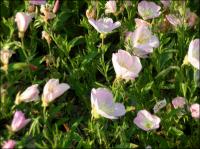Description
ARCHIVED
Note: This is a plant not currently for sale. This is an archive page preserved for informational use.
June to August ballerina pink saucer-like blossoms, excellent groundcover.
June to August pale pink saucer-like blossoms
ARCHIVED
Note: This is a plant not currently for sale. This is an archive page preserved for informational use.
June to August ballerina pink saucer-like blossoms, excellent groundcover.
In May and June yellow petticoats peek out from under eye-popping red skirts flaring at the ends as these flowers dangle from tall stems.
Size: 24-36”x 12”
Care: part shade in moist well-drained soil - moist in spring & dry in summer
Native: Eastern Canada to Florida, west to New Mexico, Wisconsin native.
Wildlife Value: Provides rich, early spring nectar for bumblebees, bees, butterflies, and hummingbirds. Buntings and finches eat seeds. Sole food source for Columbine duskywing caterpillar.
Awards: England’s Royal Horticultural Society Award of Merit.
Seeds are fragrant when crushed, used by Omaha, Ponca and Pawnee as perfume. Pawnee used the plant as a love charm by rubbing pulverized seeds in palm of hand and endeavoring to shake hand of desired person. Crushed seeds also used to cure fever and headaches. Cherokee made a tea for heart trouble. The Iroquois used the plant to cure poisoning and to detect people who were bewitched. Grown by Tradescant the Elder in England in 1632. He may have received it from France. Cultivated by Washington & Jefferson. Grown at America’s 1st botanic garden, Elgin Botanic Garden 1811.
Towering creamy white flower spikes in May & June followed by dark seed pods.
Size: 3-5' x 2-3'
Care: full sun to part shade in rich well-drained soil.
Native: Wisconsin native – from Minnesota to Texas.
Wildlife Value: food source for several caterpillars and nectar and pollen for a number of butterflies and bees. Deer resistant.
Winnebago (HoChunk) mashed cooked root to make a poultice applied to remedy inflammation of the womb. Baptisia is Greek meaning to dye referring to use of Baptisia australis as a substitute for indigo dye. Leucantha means white flowered.
OUT OF STOCK
Grown for its silver-grey foliage in the garden & dried in arrangements
Size: 3’ x 2’ and spreading
Care: sun in well-drained soil
Native: Colorado south to Texas, west to California.
Size: Cut fresh or dried flowers, prairie garden
Blackfoot used the leaves to clean themselves as part of religious rituals. California’s Shasta Indians used the leaves to prepare dead bodies to be buried. HoChunk made a smudge to revive the unconscious. Cahuilla Indians made baskets and roofs and walls of their homes with the stems. First collected for gardens by Meriwether Lewis October 1, 1804 in South Dakota. Artemisia named for the wife of Mausolus, king of Caria, who began using the plants and adopted it as hers. Miller 1768.
Foot-long spires of indigo blue pea-like flowers (it’s a legume) in June followed by ornamental black seed pods on this perennial that looks like a shrub. Internationally known garden designer Piet Oudolf’s 100 “MUST HAVE” plants, Gardens Illustrated 94 (2013).
Size: 3' x 3'
Care: Full sun in well-drained soil. Heat and drought tolerant.
Native: Eastern United States, Wisconsin native.
Wildlife Value: Food source for several caterpillars and nectar for a number of butterflies. Deer resistant.
Awards: Received England’s Royal Horticultural Society Award of Merit. Perennial Plant Association Plant of the Year Award, 2010. Missouri Botanic Garden Plant of Merit
Baptisia is Greek meaning to dye referring to use of the plant as a substitute for indigo dye. Cherokee used Baptisia australis for a number of illnesses: cease mortification, cure toothaches. Collected by John Bartram (1699-1777) plant explorer and colonial nurseryman by 1748.

